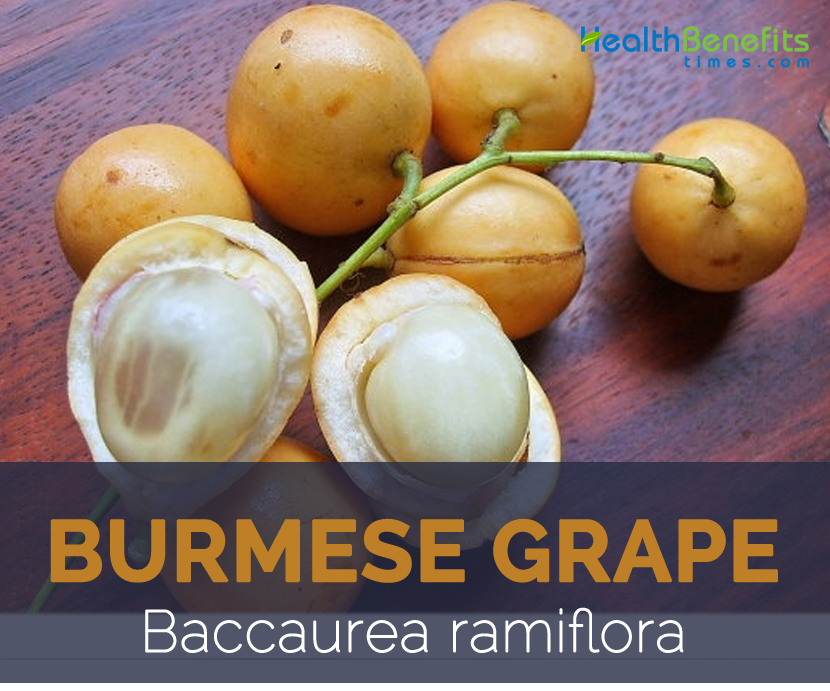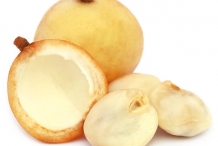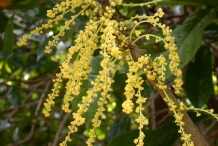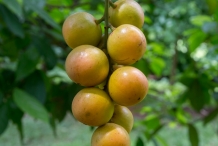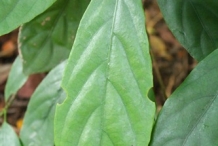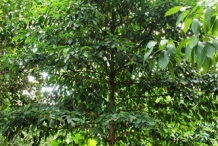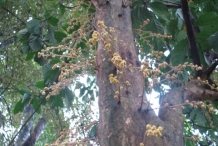Plant
Burmese grape is a minor underexploited fruit crop under the Euphorbiaceae family. It is a medium-sized, slow growing evergreen tree which reaches up to 15-25 m tall and 25-70 cm in diameter with a round and a shady crown. It has gray-brown bark, buttressed trunk and hispid branchlets which become glabrescent with age. The plant prefers a position in full sun, succeeding also in light shade. It is found growing in sandy and granite soils but it succeeds in a wide range of soils, in well-drained as well as wetter sites.
Leaves
Leaves are simple, 9-25 by 3-9 cm. Alternate and spirally-clustered at intervals along the twigs, narrowly elliptic or obovate, apex acuminate, base acute, margin entire or slightly undulate, reddish when young, finely brown-hairy, becoming dark green and shiny above and glabrous when mature. Midrib flat above, prominent below, secondary veins oblique to the midrib, widely parallel, looped and joined at margin, tertiary veins reticulate. Petiole slender swollen at top and base and Stipules are caducous.
Flower
Flowers small grouped in raceme, axillary to cauliflorous, males and females are on different trees. Males smaller arranged in slender clusters of 10 cm. long, mostly at the end of the branches, individual flower with short pedicel. Female slightly bigger, racemes clustered of 30 cm long on old branches and main trunk. Flowering normally takes place from April to May.
Fruit
Fruit is a baccate berry, globose, ovoid to slightly pear-shaped, 2–3.7 × 1.4–3 cm, indehiscent, 3-celled hanging along old branches and main trunk. The fruit is green colored while young turning yellow, red or even deep purple as they mature. Juicy white to pinkish white, translucent pulp is enclosed by leathery rind and in the middle of the pulp there are several small, hard seeds, flat-elliptic or rotund, 1–1.3 cm with purplish red testa which is edible. The fruits have a succulent, sour and sweet taste. The fruit is used locally, consumed as a fruit, stewed or made into wine; it is also used therapeutically to treat skin diseases. Bark, roots and wood are harvested for medicinal uses. Its texture resembles a lychee fruit, but is less juicy and more fibrous.
History
Wild distribution of Burmese grapes occurs in India (Assam), Burma, China (Yunnan, Hainan), Vietnam, Laos, Thailand, Andaman and Nicobar Islands, Peninsular Malaysia. It is commonly cultivated in home backyards in Peninsular Malaysia, Burma and Thailand. Currently it is grown throughout the world because of its delightful taste and wonderful nutritional value.
Nutritional Value
Apart from their sour and sweet taste, Burmese grape is a good source of nutrients, vitamins and minerals. Consuming 100 gram of Burmese grapes offers 55 mg of Vitamin C, 3.3 mg of Iron, 10.5 g of Carbohydrate, 0.7 g of Protein, 0.3 g of Total Fat and 2 mg of Calcium.
Health benefits of Burmese grape
Burmese grape commonly known as mafia fruit is one of the wonderful source of essential nutrients, minerals, vitamins. Mafai can help with bone health, ensures a Healthy Pregnancy, Bone Health, Common Cold, Muscular health, Provide Energy, Immunity and Weight Loss! Listed below are some of the popular health benefits of consuming Burmese grapes:
1. For Weight Loss
Vitamin C rich fruits and juices are proven to help people lose fat and maintain healthy weight. Popular dieticians and nutritionists always include Vitamin C fruits and vegetables in diet charts because there is scientific evidence that shows that eating Vitamin C rich foods on a regular basis helps in losing weight considerably. Doctors have found that eating Vitamin C fruits lowers insulin. Thus, instead of storing sugar and converting it into fats, it uses it as a fuel that leads to weight loss. Burmese grapes is also one of the best source of vitamin C so including this grape will definitely help you to lose weight significantly.
2. Immunity
A Burmese grape is needed for the immune system of the body, in which it helps to strengthen and promote the defense line to protect us from various ailments and diseases because it is a wonderful source of iron. Additionally, red blood cells are beneficial for healing process of damaged cells, tissues and organs as they are the carrier of oxygen. So, to have a good health and stay safe from various diseases, you need to get a balanced diet with a proper amount of iron rich foods. Burmese grapes consist of 3.3 mg of iron which is actually 41.25% of the daily recommended value. So include Burmese grapes in your regular diet to make your immunity strong.
3. Provide Energy
Almost all our activities need energy. Even a simple activity like walking or even breathing needs energy. The main source of energy required for your daily requirements comes from glucose. The source of glucose is from the starches and sugars you eat. Starches and sugars get broken down to simple sugar with help of insulin during the process of digestion. Glucose is then enters the cell wall. The extra sugar available from food gets stored muscles, liver, or other parts of your body. This then gets converted in fat later. A Burmese grape is one of the best options for fulfilling the required amount of energy for the body.
4. Muscular health
Proteins contained in Burmese grapes play an important role in muscle contraction and coordination. Proteins are present in the muscle tissues in the form of many microfilaments and provide muscle structure. Muscle growth depends on the adequacy of proteins in the body. It is extremely important to create a balance between the rate of muscle protein synthesis and the breakdown of these muscle proteins. The rate of breakdown of muscle proteins varies depending upon specific conditions for example, the requirement of protein is different during old age, when the breakdown of muscles accelerates and is different for strength trainers who would also need to consider perfect timing along with the amount of protein intake.
5. Common Cold
Frequent consumption of Burmese grapes help to decrease the severity of cold and flu attacks since it consists of considerable amount of vitamin C. It lessens the nauseating effects of common cold, including inflammation and a runny nose. It not only controls the allergy that causes cold but also, shortens the duration of cold. It is a known fact that Vitamin C tends to boost your immunity. So including Burmese grapes in your diet is one of the best options to overcome common cold.
6. Bone Health
Burmese grapes consist of good amount of calcium which helps to prevent osteoporosis. Calcium is the most vital nutrient for developing strong bones, particularly for children and young adults. Calcium absorption as well as bone development is at its peak till the age of 20, and decreases gradually thereafter. Sufficient amount of calcium and vitamin D helps to increase bone mass in growing children and young adults. Regular consumption of Burmese grapes is also one of the best options to fulfill calcium requirement.
7. Ensures a Healthy Pregnancy
Normally doctors recommend pregnant women to increase their intake of iron from food sources or supplements. Research reports that the prenatal supplementation of iron helps lower the risk of low birth weight and prevents maternal anemia during pregnancy. Pregnant women should take 27 milligrams of iron a day. Iron supplements are best absorbed when supplemented with foods rich in vitamin C, such as orange, grapefruit, and tomato juice. Apart from that Burmese grapes is also one of the best source of iron therefore including it in your regular diet is quite beneficial for pregnant woman.
How to Eat
- Mafai fruits can be eaten fresh.
- Fruits can also be stewed or can be used to make wine.
- Fruit makes a quite good wine.
- Pulp is eaten directly and usually the seeds are also swallowed.
- Rind of the fruits is occasionally used for making chutney.
- Squash-making has increased the value of the fruits as the fruit is rich in vitamin C.
- Mafai drink is quite popular in Thailand.
- Young tender leaves and flowers are also eaten.
- Flower is eaten raw in northeast India.
Other Traditional Uses and benefits of Burmese Grapes
- Roots, bark and wood are harvested to treat skin diseases.
- Hill tribes in northern Thailand used the bark, root bark and wood in decoction of dried and grinded material as folkloric medicine.
Other Facts
- Tree is often cultivated in the home garden and intercropped with other tropical fruits like durian, rambutan, and mango.
- Bark, roots and wood are used to produce a brown-red dye.
- Bark is used as a mordant in dyeing.
- Wood is used for cabinet work, construction, agricultural implements, furniture, and boats and for smaller items.
Precautions
- Overeating has been known to cause stomach cramps in anyone not used to consuming the grapes.
References:
https://en.wikipedia.org/wiki/Baccaurea_ramiflora
http://explorers.zizira.com/exotic-fruit-sohramdieng-burmese-grape/
http://world-crops.com/burmese-grape/
http://www.ripublication.com/ijafst_spl/ijafstv4n5spl_04.pdf
http://tropical.theferns.info/viewtropical.php?id=Baccaurea+ramiflora
http://www.fruitipedia.com/kataphal_baccaurea_ramiflora.htm
http://findmeacure.com/2010/12/08/burmese-grape-baccaurea-ramiflora-lour/
http://davesgarden.com/guides/pf/go/179607/
http://www.asianplant.net/Phyllanthaceae/Baccaurea_ramiflora.htm
http://zipcodezoo.com/index.php/Baccaurea_ramiflora
Comments
| Burmese Grape Quick Facts | |
|---|---|
| Name: | Burmese Grape |
| Scientific Name: | Baccaurea ramiflora |
| Origin | India (Assam), Burma, China (Yunnan, Hainan), Vietnam, Laos, Thailand, Andaman and Nicobar Islands, Peninsular Malaysia. |
| Colors | Green when young and turn yellow, red or even deep purple when ripe. |
| Shapes | Baccate berry, globose, ovoid to slightly pear-shaped, 2–3.7 × 1.4–3 cm, indehiscent, 3-celled. |
| Flesh colors | White to pinkish white, translucent |
| Taste | Sour and sweet taste. |
| Calories | 48 Kcal./cup |
| Major nutrients | Vitamin C (61.11%) Iron (41.25%) Carbohydrate (8.08%) Protein (1.40%) Total Fat (0.86%) |
| Health benefits | Ensures a Healthy Pregnancy, Bone Health, Common Cold, Muscular health, Provide Energy, Immunity, For Weight Loss |
| More facts about Burmese Grape | |
| Rank | Scientific Name & (Common Name) |
|---|---|
| Kingdom | Plantae (Plants) |
| Subkingdom | Tracheobionta (Vascular plants) |
| Superdivision | Spermatophyta (Seed plants) |
| Division | Magnoliophyta (Flowering plants) |
| Class | Magnoliopsida (Dicotyledons) |
| Subclass | Rosidae |
| Order | Euphorbiales |
| Family | Euphorbiaceae (Spurge family) |
| Genus | Baccaurea Lour. (Baccaurea) |
| Species | Baccaurea ramiflora Lour. (Baccaurea) |
| Synonyms |
|


